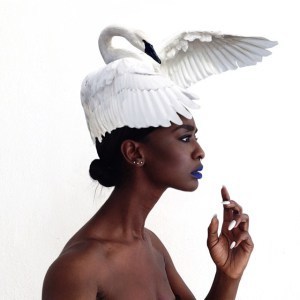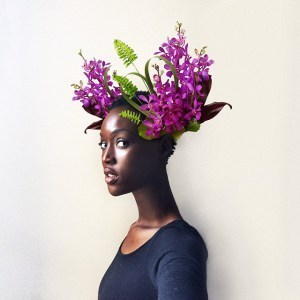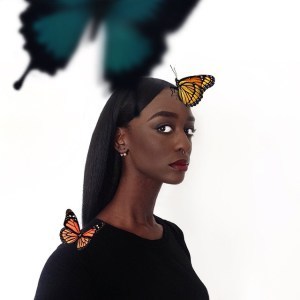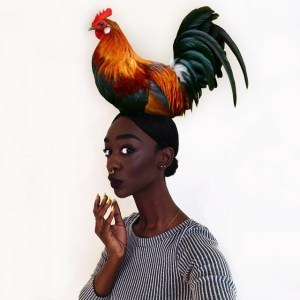Sean Jacobs's Blog, page 363
February 20, 2015
5 Questions for a Filmmaker–Tunde Kelani
Living legend, award-winning filmmaker and storyteller ’s (a.k.a. TK) grew up in the town of Abeokuta – home to two other legends; Wole Soyinka and musician Fela Kuti.
As a director of numerous blockbusters in indigenous Nigerian languages, TK, whose career spans over four decades, has been lauded for efforts to promote Nigeria’s cultural heritage in general and Yoruba culture in particular. With a preference for adapting literary works, he has been referred to as a ‘bridge between the first generation of Nigerian filmmakers and the Nollywood era’. Among TK’s most famous films are Maami, which is based on author Femi Osifisan’s novel by the same name, the 2009 AMAA-winner Arugba and Abeni.
Kelani’s latest film – a love story – Dazzling Mirage, produced by his company MainFrame Productions, will be released on the Nigerian cinema circuit Friday the 20th Feb 2015 by Filmhouse Cinemas.
1) What is your first film memory?
It was in primary school. I sat on a bench, open air with others my age, watching our very first film that night. It was probably a documentary or wild life because a herd of elephants charged straight at us. I ducked further in my seat to avoid the approaching beasts and if necessary could have taken to my heels. It was so real and powerful that I have never forgotten the experience.
2) Why did you decide to become a filmmaker?
I did not plan to be a filmmaker but started photography from an early age. I read a lot, and my reading coupled with the oral tradition and socio-cultural diversity of my Yoruba lineage helped me develop a rich visual sense. I was trained in television as a film cameraman but I opted for giant pictures at the cinemas and not the small picture on the television box. When I realized that was I wanted to do, I decided to go to London Film School.
3) Which film do you wish you had made and why?
I have always desired to make an adaptation of Cyprian Ekwensi‘s fascinating story Passport of Mallam Ilia. The protagonist is a Mallam from Northern Nigeria and the author is from Eastern Nigeria. With me, being from Western Nigeria, as the director the film would blur the divisions, making the project truly national.
4) Name one of the films on your top-5 list and the reason why it is there.
Lawrence of Arabia was one of the first films I saw on the local cinema screen in Lagos. Apart from looking gigantic, it introduced me to my first Hollywood cinema idols, Peter , , , , . I did not understand the story at that time but it did not matter to me at all because I enjoyed the adventure and have continued to enjoy great visuals since.
5) Ask yourself any question you think I should have asked and answer it.
What will be the future of Nollywood?
Nollywood is already a success story – the model could be exported outside of Nigeria to any part of Africa and the Diaspora. However, there is a lot of room for improvement in terms of more quality and standard. The industry is dynamic and young, with great potential to grow beyond its traditional base and relate to other established industries, Hollywood and Bollywood.
5 Questions with a filmmaker: Tunde Kelani
Living legend, award-winning filmmaker and storyteller ’s (a.k.a. TK) grew up in the town of Abeokuta – home to two other legends; Wole Soyinka and musician Fela Kuti.
As a director of numerous blockbusters in indigenous Nigerian languages, TK, whose career spans over four decades, has been lauded for efforts to promote Nigeria’s cultural heritage in general and Yoruba culture in particular. With a preference for adapting literary works, he has been referred to as a ‘bridge between the first generation of Nigerian filmmakers and the Nollywood era’. Among TK’s most famous films are Maami, which is based on author Femi Osifisan’s novel by the same name, the 2009 AMAA-winner Arugba and Abeni.
Kelani’s latest film – a love story – Dazzling Mirage, produced by his company MainFrame Productions, will be released on the Nigerian cinema circuit Friday the 20th Feb 2015 by Filmhouse Cinemas.
1) What is your first film memory?
It was in primary school. I sat on a bench, open air with others my age, watching our very first film that night. It was probably a documentary or wild life because a herd of elephants charged straight at us. I ducked further in my seat to avoid the approaching beasts and if necessary could have taken to my heels. It was so real and powerful that I have never forgotten the experience.
2) Why did you decide to become a filmmaker?
I did not plan to be a filmmaker but started photography from an early age. I read a lot, and my reading coupled with the oral tradition and socio-cultural diversity of my Yoruba lineage helped me develop a rich visual sense. I was trained in television as a film cameraman but I opted for giant pictures at the cinemas and not the small picture on the television box. When I realized that was I wanted to do, I decided to go to London Film School.
3) Which film do you wish you had made and why?
I have always desired to make an adaptation of Cyprian Ekwensi‘s fascinating story Passport of Mallam Ilia. The protagonist is a Mallam from Northern Nigeria and the author is from Eastern Nigeria. With me, being from Western Nigeria, as the director the film would blur the divisions, making the project truly national.
4) Name one of the films on your top-5 list and the reason why it is there.
Lawrence of Arabia was one of the first films I saw on the local cinema screen in Lagos. Apart from looking gigantic, it introduced me to my first Hollywood cinema idols, Peter , , , , . I did not understand the story at that time but it did not matter to me at all because I enjoyed the adventure and have continued to enjoy great visuals since.
5) Ask yourself any question you think I should have asked and answer it.
What will be the future of Nollywood?
Nollywood is already a success story – the model could be exported outside of Nigeria to any part of Africa and the Diaspora. However, there is a lot of room for improvement in terms of more quality and standard. The industry is dynamic and young, with great potential to grow beyond its traditional base and relate to other established industries, Hollywood and Bollywood.
File Under Climate Change: What if Malawi has to cope with another severe flood
In the year 2000, the citizens of Mozambique suffered a severe flood event. Hundreds died, and many more were displaced. This intense level of flooding was believed to be a one-in-fifty year event for the region. Fifteen years later, in January this year, Malawi and Mozambique have been hit by another extreme flood event. It would seem that global climate modeling projections indicating frequent drought and flood events in the region are not far off the mark. The possibility of increased frequency of such events, coupled with weak disaster risk reduction and climate change adaptation mechanisms in the countries affected is disconcerting.
The floods that have devastated much of the southern region of Malawi represent one of the worst natural disasters in the country’s history. Casualty counts, and numbers of people displaced, are rising all the time and people are still flocking to camps that have been set up. The suite of challenges facing the country is just beginning with the aftermath involving struggles to improve difficult sanitary conditions in camps, infrastructural damage, power shortages, and finding a way to somehow help those who have lost everything. The immediacy and urgency of the response should not obscure the need to review the causes and ensure that the country is better prepared to handle this situation in the future.
Satellite records have shown that parts of the southern region received up to 913mm of rain between the 8th and the 15th of January with much of that falling over the final three days. To put this into perspective, that is over four times the average monthly rainfall usually expected in January. The situation was unprecedented and Malawi was unprepared to deal with it.
The response to the disaster has been immediate, with different humanitarian groups working with the Government to help those in need. The whole country has mobilized in sending resources through various charities to support the people affected. While there is no doubt about the sincerity of the reaction, the lack of preparedness is something that cannot be risked in the future.
As a Malawian working in the climate change and natural resource management sectors, the rapid decline of natural and social systems has been harrowing to witness. We have spent much of the last few generations decimating our forests. We cultivate on slopes and river banks with no concern for buffer zones or natural flood attenuation measures. We have almost systematically set about reducing the capabilities of the natural system to absorb such an event. The same approach is prevalent in infrastructure development; we build our roads without incorporating adequate drainage options. We stay in compact, densely populated areas which are highly vulnerable to floods. We chop trees down and rip up gardens replacing the spaces with concrete all in the name of development. Government has not modeled good practice either. The department that is tasked with dealing with disasters is under-resourced and unprepared. Local government structures which are key to response in these events are weak and marginalised. National legislation on disaster risk has been in development for years and is yet to be passed, and to top this all off we have a recent history of serious misuse of public resources.
Such rainfall events are unprecedented, but given the onset of global climate change, the likelihood of facing similar conditions in the future is increasing. How can we improve disaster risk reduction and disaster response measures to deal with events of this magnitude?
Climate change is one of the biggest challenges facing the nation today. One of the expected impacts is the increase in frequency and magnitude of storm events. The low pressure system that was key in drawing in moisture that led to the floods was an unusual event for this time of year but may well recur again.
The loss of life and damage is irreversible. The way to honour the memory of those people who have lost their lives is to make an active and concerted effort to ensure that this does not happen again. The road back will be long and hard but we owe it to those who have suffered, and to ourselves as a nation, to ensure that we adequately equip ourselves for the future. Malawi needs its leaders and citizens to actively push the climate change adaptation agenda both nationally and internationally. It’s time to change the way we do things.
February 18, 2015
The BLK Brother: uniting Johannesburg’s finest BLK JKS and The Brother Moves On
In 2013 South African alterna-rockers, BLK JKS and The Brother Moves On, met in Paris to represent their country in a show called “Rock in Johannesburg.” Although both groups hail from the same place, they found it hard to collaborate there, and found it strange that they were first uniting (and bonding) in a European capital. So to rectify the situation they put together a “dream gig” combining the talents of both bands with some special invited guests that include: Moonchild, Joao Orecchia from Motel Mari, Nosisi Ngakana from Kwani Experience, Neo Hlusku, Makhafula Vilakazi, and the Blk Diamond Butterfly Thandiswa Mazwai.
The show will take place this February 28th somewhere in Johannesburg. Want to find out where? Follow the hashtag #FOLLOWTHEBLKRABBIT for details in the lead up to the day!
The BLK Brother: uniting Johannesburg’s finest this February 28th!
In 2013 South African alterna-rockers, BLK JKS and The Brother Moves On, met in Paris to represent their country in a show called “Rock in Johannesburg.” Although both groups hail from the same place, they found it hard to collaborate there, and found it strange that they were first uniting (and bonding) in a European capital. So to rectify the situation they put together a “dream gig” combining the talents of both bands with some special invited guests that include: Moonchild, Joao Orecchia from Motel Mari, Nosisi Ngakana from Kwani Experience, Neo Hlusku, Makhafula Vilakazi, and the Blk Diamond Butterfly Thandiswa Mazwai.
The show will take place this February 28th somewhere in Johannesburg. Want to find out where? Follow the hashtag #FOLLOWTHEBLKRABBIT for details in the lead up to the day!
The selective memory of ‘Plot for Peace,’ documentary film about South Africa’s transition
At the opening of the documentary Plot for Peace, Jean-Yves Ollivier puts his story in the audience’s hands: “I know questions are already being asked and some are wondering how the audience will react, whether people will be gripped by my story. Well it’s up to the audience to decide.”
Plot for Peace tells the story of Ollivier, a French oil and coal trader, who intervened in southern Africa’s liberation wars. The film suggests that Nelson Mandela’s release from prison was the direct outcome of Ollivier’s game of cards, in which he used business contacts to bring together key players in the Cold War in southern Africa. According to the film, Ollivier’s crucial move was to organize the 1987 prisoner exchange of South African Major Wynand du Toit, who had been captured in Angola, in exchange for 133 Angolan soldiers held by the South African-supported UNITA. According to Ollivier, this exchange set in motion the wheels of negotiation that led to Mandela’s release three years later.
Former Mozambican Minister for Security and Cooperation and mining investor Jacinto Veloso is a bit skeptical that this negotiation was Ollivier’s disinterested “plot for peace.” Instead, he suggests that Ollivier operated. “…like any businessman. If he can intervene and get an advantage so much the better…” [6:36] Ollivier, born to a French family in Algeria and a teen during Algeria’s battle for independence, disregarded sanctions against apartheid South Africa. Yes, he saw apartheid as backward, but he judged embargoes as a counterproductive strategy, despite the anti-apartheid movement’s call for boycotts. The details of Ollivier’s business dealings are not surprisingly left out of Plot for Peace, but he admits he did business in “difficult countries which needed more than pricing.”
Plot for Peace was funded by the Ichikowitz Family Foundation. Ivor Ichikowitz (who Patrick Bond has called “Africa’s most aggressive arms dealing entrepreneur”) has been criticized for his close connections with the ANC, including Matthews Phosa (interviewed in the film about the ANC, Cuba, and Angola), Moeletsi Mbeki (former president Thabo’s brother) and Sandile Majali (best known for the Oilgate scandal). Many of the interviews in the film are from the African Oral History Archive, an Ichikowitz Family Foundation-funded project to collect interviews with important figures of the liberation struggle.
While the film compellingly presents back alleys, dark cars, and plane hopping, Ollivier’s strategizing is not surprising—and therefore less captivating. To its detriment, Plot for Peace divorces Ollivier’s actions from the numerous other behind-the-scenes negotiations by politicians and businessmen in the transition from apartheid to democracy in South Africa. As early as 1985, Gavin Relly of the Anglo-American Corporation led South African businessmen to meet with Oliver Tambo and the ANC in exile in Zambia. The same year, Frederik Van Zyl Slabbert, the leader of the opposition Progressive Federal Party, also led a delegation to meet the ANC. Pieter de Lange, an academic and chairman of the Afrikaner Broederbond, met with Thabo Mbeki and the ANC in New York in 1986; in 1987, Slabbert’s Institute for a Democratic Alternative for South Africa (IDASA) organized a meeting of high profile ANC exiles, including Mbeki. Mandela wrote in great length about his decisions to begin talks with apartheid officials from prison after rejecting conditional release in 1985. Mark Gevisser’s autobiography of Mbeki much more convincingly positions Mbeki as THE behind-the-scenes negotiator.
All this Plot for Peace leaves out, in favor of Ollivier’s maneuvers at the coal face of late Cold War intrigues. The film does effectively situate Ollivier’s card game within the Cold War context. But at times it too readily accepts apartheid explanations of their position as a bulwark against communism on the African continent. While the film opens with the violence in South Africa’s streets, little is done to explain it as anything other than the brutality of apartheid forces and hatred between whites and blacks. Ollivier speaks of the manner in which South Africa sought to destabilize the frontline states, but the film does not connect several of the key protagonists and interviewees of the film to the violence that they actually fostered. The documentary’s insiders include Foreign Minister “Pik” Botha—who once suggested to the TRC that language such as “track down and destroy,” “remove permanently from society,” and “obliterate” did not mean killing anti-apartheid activists—and General Neels van Tonder, head of Military Intelligence, who was responsible for organizing the training of Inkatha vigilante forces in Operation Marion.
Ultimately, the question about Plot for Peace is not as Ollivier asked, whether his story is gripping. But rather, why is this the story being told? What is not being shared here? And who gains from this rather selective telling?
The selective memory of ‘Plot for Peace,’ documentary film about South African transition
At the opening of the documentary Plot for Peace, Jean-Yves Ollivier puts his story in the audience’s hands: “I know questions are already being asked and some are wondering how the audience will react, whether people will be gripped by my story. Well it’s up to the audience to decide.”
Plot for Peace tells the story of Ollivier, a French oil and coal trader, who intervened in southern Africa’s liberation wars. The film suggests that Nelson Mandela’s release from prison was the direct outcome of Ollivier’s game of cards, in which he used business contacts to bring together key players in the Cold War in southern Africa. According to the film, Ollivier’s crucial move was to organize the 1987 prisoner exchange of South African Major Wynand du Toit, who had been captured in Angola, in exchange for 133 Angolan soldiers held by the South African-supported UNITA. According to Ollivier, this exchange set in motion the wheels of negotiation that led to Mandela’s release three years later.
Former Mozambican Minister for Security and Cooperation and mining investor Jacinto Veloso is a bit skeptical that this negotiation was Ollivier’s disinterested “plot for peace.” Instead, he suggests that Ollivier operated. “…like any businessman. If he can intervene and get an advantage so much the better…” [6:36] Ollivier, born to a French family in Algeria and a teen during Algeria’s battle for independence, disregarded sanctions against apartheid South Africa. Yes, he saw apartheid as backward, but he judged embargoes as a counterproductive strategy, despite the anti-apartheid movement’s call for boycotts. The details of Ollivier’s business dealings are not surprisingly left out of Plot for Peace, but he admits he did business in “difficult countries which needed more than pricing.”
Plot for Peace was funded by the Ichikowitz Family Foundation. Ivor Ichikowitz (who Patrick Bond has called “Africa’s most aggressive arms dealing entrepreneur”) has been criticized for his close connections with the ANC, including Matthews Phosa (interviewed in the film about the ANC, Cuba, and Angola), Moeletsi Mbeki (former president Thabo’s brother) and Sandile Majali (best known for the Oilgate scandal). Many of the interviews in the film are from the African Oral History Archive, an Ichikowitz Family Foundation-funded project to collect interviews with important figures of the liberation struggle.
While the film compellingly presents back alleys, dark cars, and plane hopping, Ollivier’s strategizing is not surprising—and therefore less captivating. To its detriment, Plot for Peace divorces Ollivier’s actions from the numerous other behind-the-scenes negotiations by politicians and businessmen in the transition from apartheid to democracy in South Africa. As early as 1985, Gavin Relly of the Anglo-American Corporation led South African businessmen to meet with Oliver Tambo and the ANC in exile in Zambia. The same year, Frederik Van Zyl Slabbert, the leader of the opposition Progressive Federal Party, also led a delegation to meet the ANC. Pieter de Lange, an academic and chairman of the Afrikaner Broederbond, met with Thabo Mbeki and the ANC in New York in 1986; in 1987, Slabbert’s Institute for a Democratic Alternative for South Africa (IDASA) organized a meeting of high profile ANC exiles, including Mbeki. Mandela wrote in great length about his decisions to begin talks with apartheid officials from prison after rejecting conditional release in 1985. Mark Gevisser’s autobiography of Mbeki much more convincingly positions Mbeki as THE behind-the-scenes negotiator.
All this Plot for Peace leaves out, in favor of Ollivier’s maneuvers at the coal face of late Cold War intrigues. The film does effectively situate Ollivier’s card game within the Cold War context. But at times it too readily accepts apartheid explanations of their position as a bulwark against communism on the African continent. While the film opens with the violence in South Africa’s streets, little is done to explain it as anything other than the brutality of apartheid forces and hatred between whites and blacks. Ollivier speaks of the manner in which South Africa sought to destabilize the frontline states, but the film does not connect several of the key protagonists and interviewees of the film to the violence that they actually fostered. The documentary’s insiders include Foreign Minister “Pik” Botha—who once suggested to the TRC that language such as “track down and destroy,” “remove permanently from society,” and “obliterate” did not mean killing anti-apartheid activists—and General Neels van Tonder, head of Military Intelligence, who was responsible for organizing the training of Inkatha vigilante forces in Operation Marion.
Ultimately, the question about Plot for Peace is not as Ollivier asked, whether his story is gripping. But rather, why is this the story being told? What is not being shared here? And who gains from this rather selective telling?
Ivorian designer Loza Maléombho’s #AlienEdits series elevates the selfie
Susan Sontag declared in her discerning 1977 book On Photography, “Photography has become almost as widely practiced an amusement as sex or dancing – which means that, like every mass art form, photography is not practiced by most people as an art.” Indeed with the proliferation of powerful cameras and smartphones, most anyone can access the tools to take a picture. Now, what qualities allow a photograph to enter into the realm of art may be highly subjective, but what is clear is that within the medium of photography, some images clearly have greater social resonance than others.
This is especially true in the world of instagram where there are an estimated 70 million photos uploaded to the social image sharing network daily. Many of the images merely serve as evidence of the users’ daily lives, but a few imagemakers go beyond this memorialization of mundanity by sharing works that seek to affect social consciousness.
Ivoirian designer Loza Maléombho has struck such a social chord by developing an image series on instagram called #AlienEdits, which fuses cultural significance with aesthetic quality in the ubiquitous form of the selfie. The #AlienEdits series was initially developed as an uplifting response to the alienation, discrimination and misrepresentation black and brown people frequently experience at the hands of oppressive institutions, though it has since evolved to feature new faces and cultural themes.
By focusing largely on the selfie, Loza transforms herself into a work of art and becomes both the observer and the observed, thereby placing the power of representation in her own hands. This determination of her own likeness is an act of reclaiming her image and she does so with a grace that makes the viewer wonder who really is the alien after all. And in doing so, the normally self-indulgent selfie is given a greater purpose.
We spoke to Loza about the inspiration for her visual quotations of culture, instagram as gallery and the evolution of the #AlienEdits series.
The #AlienEdits series seems to come as a form of resistance to negative social projections regarding race, gender, sexuality, culture etc. Can you speak to what sparked the series?
“Alien Edits” are socially conscious selfies expressed through style, pride, grace, and cultural awareness and against racial, class, cultural, religious and sexuality stereotypes, all of which cause a state of alienation on its victims.
The recent US judiciary system’s discriminative decisions against African Americans such as in the case of Michael Brown in Ferguson as well as the lack of sensitivity from African governments towards human rights in the case of the 200 girls being kidnapped by Boko Haram in Nigeria, are most responsible for the series. I think the spark happened after the grand jury found Darren Wilson not guilty in the case of Mike Brown. The decision carried emotions of deep despair which I think were felt amongst African Americans and also Africans of the diaspora. While I empathised with sadness and anger on that day, I also felt deeply devalued, even alienated in some way. I needed to quickly eradicate those feelings for me and anyone like me by nurturing the exact opposite: Pride and self-validation. Ever since then “Alien Edits” became a way to respond to current events, celebrate cultural diversities and traditions, and communicate with people of my generation.
Is each image a version of yourself or an imagined persona?
Sometimes it is a version of me, other times it is who I aspire to be. For instance “Helmet of Grace” represents a persona who is simultaneously protected by and leading with “Grace” when challenged by feelings of anger or an impulsion to speak without control. The latter is a trait of personality I often struggle with. When I am confronted with injustice I tend to let anger speak louder instead of thinking first. This is something I’d like to change. On the other hand, the image “Own Yours” is a projection of myself as an artist owning and maturing in a world I have created.
How does the public interface of instagram fare as a gallery wall?
We are a generation stigmatised as “Selfie-obsessed,” which in itself calls for a narcissistic stereotype. I intended to defy that notion by spreading socially conscious messages and stimulating a paradox, while doing so through the selfie itself. Since I am taking selfies it only made sense to display them via Instagram to begin with. It is a direct window to the audience I am talking to who can relate to both content and medium. The message couldn’t spread any easier.
How do you see the series evolving with new faces entering the frame?
I recently started introducing young influential Africans of the diaspora to the series because I’d like to extend the conversation to a wider audience. I am interested in what everyone is saying and I am open to help communicate these emotions through the series. I am looking to empower victims of stereotypes and discrimination with these positive messages.
* Loza Maléombho is a fashion designer based in Abidjan, Cote d’Ivoire. Check her out on instagram and visit her website.
Loza Maléombho’s #AlienEdits series elevates the selfie
Susan Sontag declared in her discerning 1977 book On Photography, “Photography has become almost as widely practiced an amusement as sex or dancing – which means that, like every mass art form, photography is not practiced by most people as an art.” Indeed with the proliferation of powerful cameras and smartphones, most anyone can access the tools to take a picture. Now, what qualities allow a photograph to enter into the realm of art may be highly subjective, but what is clear is that within the medium of photography, some images clearly have greater social resonance than others.
This is especially true in the world of instagram where there are an estimated 70 million photos uploaded to the social image sharing network daily. Many of the images merely serve as evidence of the users’ daily lives, but a few imagemakers go beyond this memorialization of mundanity by sharing works that seek to affect social consciousness.
Ivoirian designer Loza Maléombho has struck such a social chord by developing an image series on instagram called #AlienEdits, which fuses cultural significance with aesthetic quality in the ubiquitous form of the selfie. The #AlienEdits series was initially developed as an uplifting response to the alienation, discrimination and misrepresentation black and brown people frequently experience at the hands of oppressive institutions, though it has since evolved to feature new faces and cultural themes.
By focusing largely on the selfie, Loza transforms herself into a work of art and becomes both the observer and the observed, thereby placing the power of representation in her own hands. This determination of her own likeness is an act of reclaiming her image and she does so with a grace that makes the viewer wonder who really is the alien after all. And in doing so, the normally self-indulgent selfie is given a greater purpose.
We spoke to Loza about the inspiration for her visual quotations of culture, instagram as gallery and the evolution of the #AlienEdits series.
The #AlienEdits series seems to come as a form of resistance to negative social projections regarding race, gender, sexuality, culture etc. Can you speak to what sparked the series?
“Alien Edits” are socially conscious selfies expressed through style, pride, grace, and cultural awareness and against racial, class, cultural, religious and sexuality stereotypes, all of which cause a state of alienation on its victims.
The recent US judiciary system’s discriminative decisions against African Americans such as in the case of Michael Brown in Ferguson as well as the lack of sensitivity from African governments towards human rights in the case of the 200 girls being kidnapped by Boko Haram in Nigeria, are most responsible for the series. I think the spark happened after the grand jury found Darren Wilson not guilty in the case of Mike Brown. The decision carried emotions of deep despair which I think were felt amongst African Americans and also Africans of the diaspora. While I empathised with sadness and anger on that day, I also felt deeply devalued, even alienated in some way. I needed to quickly eradicate those feelings for me and anyone like me by nurturing the exact opposite: Pride and self-validation. Ever since then “Alien Edits” became a way to respond to current events, celebrate cultural diversities and traditions, and communicate with people of my generation.
Is each image a version of yourself or an imagined persona?
Sometimes it is a version of me, other times it is who I aspire to be. For instance “Helmet of Grace” represents a persona who is simultaneously protected by and leading with “Grace” when challenged by feelings of anger or an impulsion to speak without control. The latter is a trait of personality I often struggle with. When I am confronted with injustice I tend to let anger speak louder instead of thinking first. This is something I’d like to change. On the other hand, the image “Own Yours” is a projection of myself as an artist owning and maturing in a world I have created.
How does the public interface of instagram fare as a gallery wall?
We are a generation stigmatised as “Selfie-obsessed,” which in itself calls for a narcissistic stereotype. I intended to defy that notion by spreading socially conscious messages and stimulating a paradox, while doing so through the selfie itself. Since I am taking selfies it only made sense to display them via Instagram to begin with. It is a direct window to the audience I am talking to who can relate to both content and medium. The message couldn’t spread any easier.
How do you see the series evolving with new faces entering the frame?
I recently started introducing young influential Africans of the diaspora to the series because I’d like to extend the conversation to a wider audience. I am interested in what everyone is saying and I am open to help communicate these emotions through the series. I am looking to empower victims of stereotypes and discrimination with these positive messages.
Loza Maléombho is a fashion designer based in Abidjan, Cote d’Ivoire. Check her out on instagram and visit her website.
February 17, 2015
Film Review: On The Way to School
The documentary On The Way To School, directed by Frenchman Pascal Plisson, follows four children on their long and challenging journeys to school. We watch Jackson (10) and his younger sister navigate their way through the Kenyan savannah, constantly on guard for elephant attacks. In Argentina, we follow Carlito (11) as he rides his horse through the Patagonian mountains, his younger sister tightly holding onto him. In Morocco, we meet twelve-year old Zahira, as she prepares herself and her friends for their joint walk of twenty-two kilometers. And then there is Samuel, an eleven-year-old physically disabled student from the Bay of Bengal, who relies on his brothers to reach his destination. They push and pull Samuel’s broken wheelchair through potholes, wetlands and uneven roads before they –impressively and inventively- eventually drop him off in class.
Here is the trailer:
Sean Jacobs's Blog
- Sean Jacobs's profile
- 4 followers












